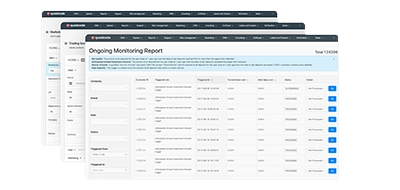Quay lại
Contents
Giải thích về giao dịch lướt sóng: Chiến lược, lợi ích và cách thức hoạt động

Vitaly Makarenko
Chief Commercial Officer

Demetris Makrides
Senior Business Development Manager
Với mục tiêu hưởng lợi từ những biến động giá ngắn hạn đến trung hạn trên thị trường, giao dịch lướt sóng (swing trading) là một phương pháp giao dịch trong đó người giao dịch nắm giữ tài sản tài chính trong khoảng thời gian từ vài ngày đến vài tuần. Các nhà giao dịch lướt sóng cố gắng kiếm lợi nhuận từ sự biến động của thị trường bằng cách nắm bắt những "biến động" hoặc thay đổi giá trị tài sản, do đó không cần phải theo dõi liên tục. Phổ biến trong số những người muốn kết hợp giao dịch tích cực với cam kết thời gian hợp lý, giao dịch lướt sóng chủ yếu dựa vào phân tích kỹ thuật để tìm kiếm cơ hội giao dịch.
Hiểu về giao dịch Swing
Giao dịch lướt sóng dựa trên ý tưởng rằng tâm lý thị trường, dữ liệu kinh tế và các biến số khác khiến giá trị tài sản dao động giữa mức cao và mức thấp thay vì di chuyển theo đường thẳng. Để quyết định thời điểm vào và thoát lệnh, các nhà giao dịch xem xét những biến động giá này. Họ tìm cách tối đa hóa lợi nhuận tiềm năng bằng cách nắm giữ vị thế trong nhiều ngày hoặc nhiều tuần, từ đó nắm bắt được những biến động giá đáng kể.
You may also like

Giao dịch lướt sóng không đòi hỏi sự chú ý liên tục của thị trường, không giống như giao dịch trong ngày, tức là mua và bán trong cùng một ngày. Điều này phù hợp với những nhà giao dịch không thể dành cả ngày để theo dõi biến động giá. Đồng thời, giao dịch lướt sóng mang lại khả năng giao dịch thường xuyên hơn và khả năng thu được lợi nhuận lớn hơn trong thời gian ngắn hơn so với đầu tư dài hạn.
Giao dịch Swing hoạt động như thế nào
Các nhà giao dịch thử nghiệm giao dịch theo xu hướng bắt đầu bằng việc nghiên cứu kỹ lưỡng thị trường để tìm ra các tài sản có khả năng biến động giá đáng kể. Điều này bao gồm việc xem xét biểu đồ, phát hiện xu hướng và dự đoán xu hướng giá trong tương lai bằng các chỉ báo kỹ thuật. Các công cụ phổ biến bao gồm các mức hỗ trợ và kháng cự, chỉ số sức mạnh tương đối và các chỉ báo kỹ thuật khác. đường trung bình động .
Khi tìm thấy một cơ hội hấp dẫn, nhà giao dịch sẽ quyết định điểm vào lệnh tốt nhất, nhắm mục tiêu giá để thoát khỏi giao dịch và tạo lệnh dừng lỗ để kiểm soát rủi ro. Vì lệnh dừng lỗ hạn chế mọi khoản lỗ nếu thị trường diễn biến trái với kỳ vọng của nhà giao dịch, nên nó rất quan trọng. Việc xác định rõ ràng các giới hạn này giúp các nhà giao dịch swing phát triển một chiến lược kỷ luật, định hướng cho các lựa chọn giao dịch của họ.
Sau khi vào lệnh, các nhà giao dịch lướt sóng theo dõi thị trường để nắm bắt tiến độ giao dịch. Mặc dù không cần phải liên tục theo dõi thị trường, nhưng việc đánh giá thường xuyên sẽ giúp họ phản ứng với những diễn biến quan trọng hoặc điều chỉnh chiến lược nếu cần thiết. Giao dịch đóng lại khi lệnh dừng lỗ được kích hoạt, giá mục tiêu được đáp ứng, hoặc dữ liệu mới buộc nhà giao dịch phải rời khỏi vị thế.
Chiến lược giao dịch lướt sóng
Giao dịch lướt sóng bao gồm nhiều kỹ thuật thường được sử dụng dựa trên nhiều khía cạnh khác nhau của phân tích kỹ thuật. Các nhà giao dịch theo xu hướng đôi khi nhận thấy rằng họ xác định được hướng đi chung của thị trường và sau đó thực hiện giao dịch theo xu hướng này. Các nhà giao dịch hy vọng hưởng lợi từ sự tiếp diễn của diễn biến thị trường hiện tại sẽ mua vào trong một xu hướng tăng hoặc bán ra trong một xu hướng giảm.
Giao dịch ngược xu hướng - tức là tìm kiếm các khả năng đảo chiều thị trường - là một chiến thuật thường được sử dụng. Với các chỉ báo như RSI, các nhà giao dịch tìm kiếm các mức quá mua hoặc quá bán và kỳ vọng giá sẽ đảo chiều. Chiến lược này đòi hỏi nghiên cứu sâu rộng và sẵn sàng hành động ngược lại với tâm lý chung của thị trường.
Giao dịch phá vỡ nhắm vào các tài sản sắp vượt qua các ngưỡng hỗ trợ hoặc kháng cự được chấp nhận. Giá vượt qua các ngưỡng này có thể báo hiệu sự khởi đầu của một xu hướng mới. Bằng cách bắt đầu các vị thế sớm trong giai đoạn phá vỡ, các nhà giao dịch lướt sóng sẽ kiếm lời từ đà tăng này.
Giao dịch thoái lui, thường được gọi là giao dịch pullback, là chờ đợi giá tạm thời đi ngược lại xu hướng chủ đạo trước khi quay trở lại quỹ đạo tự nhiên của nó. Sử dụng các mức thoái lui Fibonacci, các nhà giao dịch tìm ra những điểm thoái lui này và đặt cược có lợi nhuận ở mức giá phù hợp.
Mỗi phương pháp này đều đòi hỏi kiến thức toàn diện về phân tích kỹ thuật và áp dụng có phương pháp. Các nhà giao dịch swing giỏi thường tập trung vào một hoặc hai kỹ thuật phù hợp nhất với phong cách giao dịch và khả năng chịu rủi ro của họ.
Lợi ích của giao dịch Swing
Giao dịch lướt sóng mang lại nhiều lợi thế hấp dẫn đối với nhiều nhà giao dịch. Một trong những lợi ích chính là hiệu quả về mặt thời gian. Vì các vị thế được giữ trong nhiều ngày hoặc nhiều tuần, nhà giao dịch không cần phải theo dõi thị trường liên tục, cho phép họ cân bằng giao dịch với các cam kết khác.
Tiềm năng sinh lời đáng kể cũng là một điểm hấp dẫn khác. Bằng cách nắm bắt những biến động giá đáng kể, các nhà giao dịch lướt sóng có thể đạt được lợi nhuận đáng kể từ các giao dịch riêng lẻ. Điều này đặc biệt đúng trong các thị trường biến động, nơi giá cả có thể thay đổi nhanh chóng.
Một lợi thế lớn khác là tính linh hoạt. Cổ phiếu, ngoại hối, hàng hóa và tiền điện tử là một số sản phẩm tài chính mà người ta có thể sử dụng giao dịch lướt sóng. Sự đa dạng này cho phép các nhà giao dịch thích ứng với những thay đổi của tình hình kinh tế và tìm kiếm cơ hội trên nhiều thị trường.
Hơn nữa, vì ít giao dịch được thực hiện trong giao dịch lướt sóng hơn so với giao dịch trong ngày , thường kéo theo ít phí giao dịch hơn. Điều này có thể làm giảm tác động của hoa hồng và phí, do đó cải thiện lợi nhuận chung.
Rủi ro và cân nhắc
Giao dịch lướt sóng tiềm ẩn những rủi ro mà các nhà giao dịch phải xử lý đúng cách, ngay cả khi nó có nhiều ưu điểm. Đặc biệt trong trường hợp tài sản không được bảo đảm đầy đủ bằng lệnh dừng lỗ, biến động thị trường có thể gây ra những biến động giá bất ngờ, dẫn đến thua lỗ lớn.
Rủi ro qua đêm gây ảnh hưởng đến các nhà giao dịch; do đó, những diễn biến ngoài giờ giao dịch—chẳng hạn như các sự kiện địa chính trị hoặc thông báo kinh tế—có thể tác động đáng kể đến giá trị tài sản. Điều này có thể dẫn đến các khoảng trống giá mở trên thị trường, từ đó ảnh hưởng đến kết quả dự đoán của các giao dịch.
Giao dịch swing đòi hỏi sự kiềm chế cảm xúc. Các nhà giao dịch nên bám sát mục tiêu và tránh hành động chỉ dựa trên nỗi sợ hãi hoặc lòng tham. Việc đi chệch khỏi một kế hoạch rõ ràng có thể làm giảm hiệu quả của giao dịch swing và tăng khả năng thua lỗ.
Một nền tảng kiến thức vững chắc là điều cần thiết. Các nhà giao dịch lướt sóng chủ yếu dựa vào phân tích kỹ thuật, do đó, kiến thức vững chắc về các mô hình biểu đồ, chỉ báo và động lực thị trường là rất cần thiết. Việc duy trì kiến thức về những thay đổi trên thị trường và học tập suốt đời sẽ giúp các nhà giao dịch đưa ra những lựa chọn sáng suốt.
Những hiểu biết thực tế để giao dịch Swing thành công
Để thành công, các nhà giao dịch swing phải có một chiến lược giao dịch toàn diện, bao gồm các tiêu chí giao dịch, biện pháp quản lý rủi ro và phương pháp. Việc sử dụng hiệu quả các công cụ phân tích kỹ thuật giúp các nhà giao dịch tìm ra những cơ hội giao dịch có khả năng thành công cao.
Nếu các nhà giao dịch theo dõi tin tức thị trường và dữ liệu kinh tế, họ sẽ sẵn sàng hơn trước những thay đổi có thể ảnh hưởng đến khoản đầu tư của mình. Tự chủ - tức là tuân thủ kế hoạch giao dịch và duy trì kiểm soát cảm xúc - chính là yếu tố tạo nên thành công bền vững.
Quản lý rủi ro thực sự rất quan trọng. Sử dụng lệnh dừng lỗ và hạn chế vốn đầu tư vào một số giao dịch nhất định có thể giúp bạn tránh khỏi những tổn thất nghiêm trọng. Bằng cách thường xuyên đánh giá phương pháp và điều chỉnh dựa trên phản hồi hiệu suất, các nhà giao dịch có thể thích ứng với những thay đổi của thị trường.
Các chỉ báo chính được sử dụng trong giao dịch Swing
Giao dịch lướt sóng chủ yếu dựa vào phân tích kỹ thuật và sử dụng nhiều chỉ báo để phát hiện các triển vọng giao dịch tiềm năng và dự đoán biến động thị trường. Ví dụ về một chỉ báo cơ bản, hãy xem xét đường trung bình động (MA). Bằng cách tính trung bình giá theo thời gian và loại bỏ nhiễu, đường trung bình động giúp các nhà giao dịch xác định hướng xu hướng. Ngoài ra còn có các đường trung bình động khác, chẳng hạn như Đường trung bình động đơn giản (SMA) và Đường trung bình động hàm mũ (EMA), mỗi loại đều có trọng số khác nhau cho dữ liệu giá để phù hợp với các kỹ thuật giao dịch khác nhau.
Chỉ số Sức mạnh Tương đối (RSI) là một chỉ báo động lượng đo lường tốc độ và sự thay đổi của biến động giá trên thang điểm từ 0 đến 100. RSI hướng dẫn nhà giao dịch về các tình huống thị trường quá mua hoặc quá bán. Giá trị dưới 30 báo hiệu một tài sản có thể bị bán quá mức và sẵn sàng cho một xu hướng tăng; giá trị RSI trên 70 thường cho thấy một tài sản có thể bị mua quá mức và sắp có một đợt điều chỉnh thị trường.
Giao dịch swing cũng tận dụng rất nhiều Đường trung bình động Hội tụ Phân kỳ (MACD). Chỉ báo này giúp xác định các tín hiệu mua hoặc bán tiềm năng và thể hiện mối liên hệ giữa hai đường trung bình động của giá một tài sản. Đường MACD cắt lên trên đường tín hiệu có thể cho thấy động lượng tích cực; ngược lại, cắt xuống dưới đường tín hiệu có thể cho thấy động lượng tiêu cực.
Bao gồm một dải trung tâm (thường là đường SMA 20 ngày) và hai dải ngoài biểu thị độ lệch chuẩn trên và dưới dải giữa, dải Bollinger là một công cụ hữu ích khác. Dựa trên biến động thị trường, các dải này tăng và giảm để cho phép các nhà giao dịch đánh giá mức giá tương đối của các giá trị cao hoặc thấp. Giá chạm hoặc vượt ra ngoài phạm vi có thể cho thấy sự mở rộng quá mức và khả năng đảo chiều.
Các nhà giao dịch lướt sóng có thể đưa ra lựa chọn sáng suốt hơn về vị thế vào và ra bằng cách kết hợp các chỉ báo này vào nghiên cứu của mình. Điều quan trọng cần nhấn mạnh là việc phụ thuộc vào nhiều chỉ báo có thể xác nhận và giảm khả năng xuất hiện tín hiệu sai, từ đó cải thiện hiệu suất chung của phương pháp giao dịch.
Các khía cạnh tâm lý của giao dịch lướt sóng
Thành công của một nhà giao dịch phụ thuộc rất nhiều vào khía cạnh tâm lý của giao dịch swing. Đặc biệt khi thị trường biến động, các nhà giao dịch swing phải rèn luyện tính kỷ luật cảm xúc để bám sát chiến lược giao dịch. Người ta phải học cách kiểm soát những cảm xúc như lòng tham và nỗi sợ hãi. Trong khi lòng tham có thể khiến nhà giao dịch nắm giữ vị thế quá lâu, dẫn đến nguy cơ thua lỗ khi thị trường đảo chiều, thì nỗi sợ hãi có thể khiến họ sớm rời khỏi giao dịch, do đó bỏ lỡ những khoản lợi nhuận tiềm năng.
Đối với các nhà giao dịch lướt sóng, tính kiên nhẫn cũng là một phẩm chất tâm lý thiết yếu khác. Các vị thế được duy trì trong nhiều ngày hoặc nhiều tuần, do đó các nhà giao dịch phải đối mặt với nhu cầu phản ứng nhanh chóng với những thay đổi của thị trường ngắn hạn. Sự kiên nhẫn này giúp giao dịch diễn ra theo đúng phân tích ban đầu và tăng khả năng đạt được kết quả mong muốn.
Giao dịch lướt sóng (swing trading) về bản chất là không thể đoán trước. Các nhà giao dịch cần hiểu rằng thua lỗ là điều không thể tránh khỏi trong giao dịch và không phải giao dịch nào cũng sinh lời. Việc xây dựng khả năng phục hồi cho phép các nhà giao dịch vượt qua những sai lầm mà không bị ảnh hưởng bởi những trải nghiệm tiêu cực liên tục làm suy yếu khả năng phán đoán của họ. Duy trì thái độ tích cực và tập trung vào hiệu suất dài hạn thay vì những thành tựu tạm thời có thể cải thiện khả năng ra quyết định và thành công giao dịch nói chung.
Các kỹ thuật quản lý căng thẳng như nghỉ giải lao thường xuyên, tập luyện chánh niệm hoặc hoạt động thể chất cũng có thể giúp cải thiện sức khỏe tâm lý. Các nhà giao dịch lướt sóng tự trang bị cho mình khả năng xử lý thị trường thành công hơn và đưa ra quyết định sáng suốt dưới áp lực bằng cách ưu tiên sức khỏe tinh thần và khả năng kiểm soát cảm xúc lên hàng đầu.
So sánh giao dịch Swing với các phong cách giao dịch khác
Hiểu được sự khác biệt giữa giao dịch lướt sóng và các kỹ thuật giao dịch khác giúp các nhà giao dịch lựa chọn phương pháp phù hợp nhất với mục tiêu và lối sống của mình. Giao dịch trong ngày đòi hỏi việc theo dõi thị trường thường xuyên, điều này có thể gây áp lực và tốn thời gian, đồng thời đòi hỏi sự tập trung cao độ vào những biến động giá ngắn hạn.
Ngược lại, giao dịch vị thế dựa trên xu hướng dài hạn và nghiên cứu cơ bản đòi hỏi phải duy trì vị thế trong thời gian dài - thường là nhiều tháng hoặc nhiều năm. Phương pháp này sẽ hấp dẫn các nhà đầu tư muốn giảm thiểu sự tham gia vào việc quản lý danh mục đầu tư.
Giao dịch lướt sóng cung cấp một nền tảng trung gian giữa nhu cầu tham gia tích cực và sự tự do kết hợp các nghĩa vụ khác. Nó cho phép các nhà giao dịch tham gia vào biến động thị trường mà không bị áp lực của giao dịch trong ngày hoặc sự kiên nhẫn cần thiết cho đầu tư dài hạn.
Phần kết luận
Sử dụng biến động giá ngắn hạn đến trung hạn để tạo ra lợi nhuận, giao dịch lướt sóng là một phương pháp giao dịch linh hoạt và dễ áp dụng. Các nhà giao dịch lướt sóng có thể đàm phán hiệu quả thị trường và tìm kiếm lợi nhuận đáng kể bằng cách kết hợp quản lý rủi ro kỷ luật với phân tích kỹ thuật. Mặc dù giao dịch lướt sóng đòi hỏi chuyên môn, sự chuẩn bị kỹ lưỡng và khả năng kiểm soát cảm xúc, nhưng những lợi thế của nó thu hút các nhà giao dịch đang tìm kiếm một phương pháp tiếp cận kết hợp để tham gia thị trường.
FAQ
Quy tắc 1% trong giao dịch lướt sóng quy định rằng một nhà giao dịch không nên mạo hiểm quá 1% tổng vốn giao dịch của mình cho một giao dịch, do đó cần quản lý rủi ro và phân bổ vốn theo thời gian. Với 10.000 đô la trong tài khoản giao dịch, bạn sẽ không mạo hiểm quá 100 đô la cho bất kỳ giao dịch nào.
Bạn có thể giao dịch lướt sóng với 1.000 đô la, nhưng số vốn nhỏ có thể hạn chế khả năng đa dạng hóa của bạn và có thể khiến bạn khó chi trả chi phí giao dịch trong khi vẫn thu được lợi nhuận đáng kể. Để tăng dần số dư tài khoản nhỏ, bạn phải quản lý kỳ vọng và tập trung vào các phương pháp giao dịch có kỷ luật.
Mặc dù có thể sống dựa vào giao dịch lướt sóng, nhưng thông thường cần có vốn lớn, thành công liên tục và quản lý rủi ro chặt chẽ để tạo ra đủ thu nhập đáp ứng nhu cầu hàng ngày. Hầu hết các nhà giao dịch cũng phải tính đến khả năng lợi nhuận giảm và biến động trên thị trường.
Bắt đầu với ít nhất 2.000 đến 5.000 đô la sẽ cung cấp đủ tiền mặt để đa dạng hóa các giao dịch trong khi vẫn quản lý rủi ro. Số tiền này cho phép bạn triển khai các chiến lược quản lý rủi ro hợp lý và vẫn cho phép mở rộng quy mô vị thế đáng kể.
Đã cập nhật:
19 tháng 12, 2024




